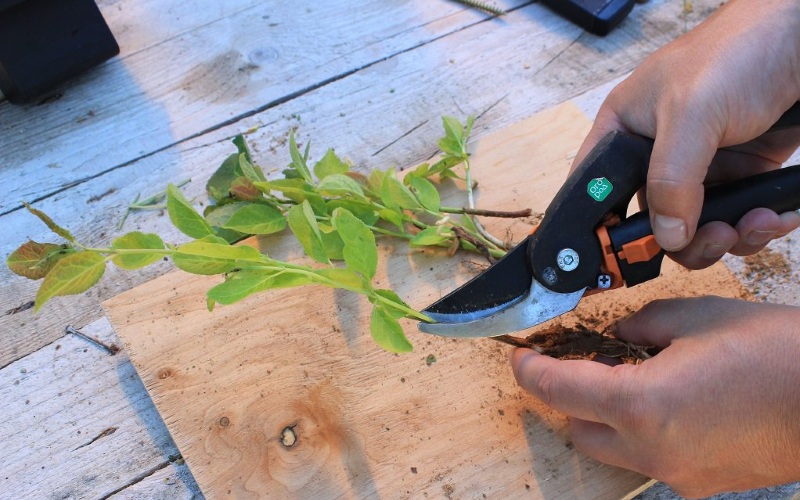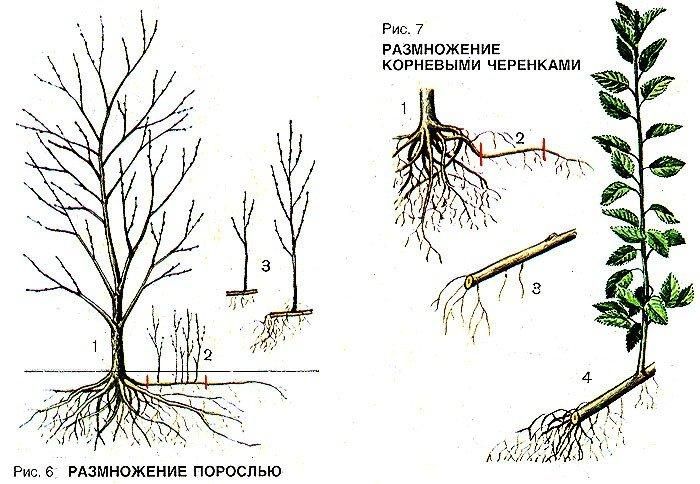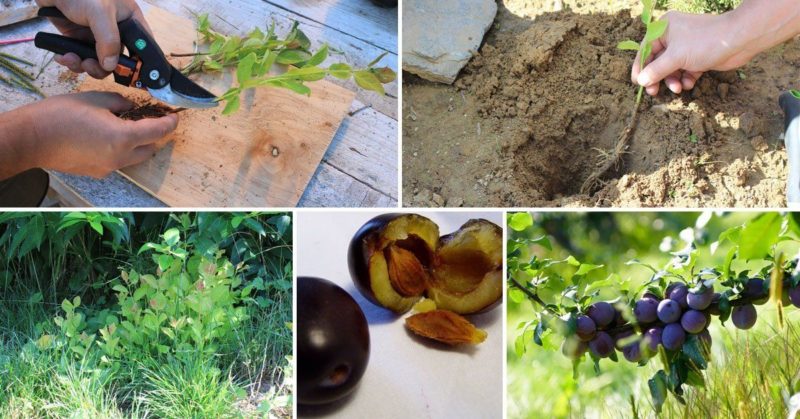Instructions for propagating plums by cuttings in summer: from preparing cuttings to caring for a seedling
Like most fruit crops, plums can be propagated artificially and naturally. The natural types of vegetative reproduction include growing from seeds, with the help of root shoots, layering. Of the artificial methods (grafting, cuttings), cuttings are the most common. How to propagate plums by cuttings, we will tell in the article.
The content of the article
Is it possible to propagate plums by cuttings in summer
The most popular method for propagating plums is lignified cuttings, which are harvested in autumn.
In recent years, the so-called green cuttings, which were previously used mainly in the industrial cultivation of fruit crops, have also become widespread in amateur gardening. With this method, summer, soft, not yet lignified cuttings are used for reproduction.

Advantages and disadvantages of summer cuttings
Benefits:
- accelerated method of growing stone fruit crops;
- high survival rate of cuttings;
- preservation of varietal qualities;
- lack of organization of winter storage of cuttings.
Disadvantages:
- not suitable for all varieties;
- requires the creation of special conditions for rooting;
- in connection with the above, an increase in financial costs is likely.
Optimal timing
While lignified stem cuttings are harvested during the dormant period of plants, green samples are cut during active vegetation, in the stage of intensive growth.
Auspicious days
Like other fruit species, the plum has an active vegetative growth in early summer.
In central Russia, the harvesting period for green cuttings lasts from early June to mid-July. A visual sign for starting work is when the growing shoots begin to turn red at the base.
In order to preserve moisture in the shoots, cutting is best done on cloudy days or in the early morning before the onset of heat.
Suitable varieties of plum

Propagation by cuttings is not suitable for all crops. Cuttings of varieties prone to the formation of dense root growth are best rooted.
Plum varieties suitable for grafting:
- Renklode Tambov;
- Hungarian;
- Memory of Timiryazev;
- Purple;
- Smolinka;
- Red dessert;
- Early ripening red;
- Volga beauty.
Selection and preparation of cuttings
Well-developed young trees with a productive root system and uterine shoots are suitable for harvesting cuttings or layering.
Having chosen a suitable day, the sections of the stems are cut with a sharp knife from healthy shoots of the current year.
How to graft:
- Each stalk - green / lignified - should have 2-4 living leaves / eyes, depending on the length of the internodes. Usually the length of the cutting is 10-15 cm.
- The shoots should be about the thickness of a pencil. This slows down the drying of the cuttings.
- The lower cut is made directly under the lower bud in an oblique line, at an angle of 45 °, in order to increase the absorption area of nutrients during rooting.
- The top cut above the sheet, on the contrary, is straight - in order to reduce evaporation. For green cuttings, the leaves are also removed for this, leaving only the upper one.
When propagating by air layers, the cuttings are prepared on the shoot of the last year and the cuttings are cut off from the mother plant after the roots appear.
The procedure for preparing the air lay is as follows:
- In the spring, an annular cut in the bark is made on the shoot at a distance of 15-20 cm from the top of the branch.
- The resulting ring without bark is wrapped in a lump of sphagnum moss and covered with plastic wrap on top.
Rooting methods
Root formation occurs under specific temperature, climatic and chemical conditions. A suitable temperature and humidity can be achieved in a greenhouse with plastic wrap stretched over arcs.
When planting woody cuttings in spring, the soil must be preheated.
Reference.The possibilities of this rooting method are expanded with the use of various commercial nurseries, including those with automatic humidification systems - fogging installations.
The simplest way of rooting at home, if there is no time to deal with a greenhouse, is to plant cuttings in pots or boxes (shelter is also necessary). It is useful to put a container of water between the pots, since the earth in them dries out faster than in the garden.
In the case of air layering, the greenhouse effect is created in moist sphagnum inside a polyethylene cover. Moss must be kept moist at all times. In such an environment, air roots form at the incision site. In autumn, layers with formed roots are carefully separated from the mother liquor and planted in the ground.
Is it possible to grow a plum from a shoot and will it bear fruit

Popular with gardeners and an easier way of vegetative propagation - with the help of root shoots - shoots formed from dormant buds on the roots of plants.
The coppice method is often used for growing plums, as many varieties of this crop are capable of forming root shoots until old age.
In this case, stems already growing from the ground are used as planting material. It remains only to competently separate the young generation from the mother.
The main secret here is the choice of promising shoots: the least suitable are those that grow close to the trunk - they have a weak and less developed root system.
At the end of summer or in autumn, at the end of the growing season, the root connecting with the main plant should be chopped off and the young tree should be transplanted to the prepared place. If everything is done correctly, the crop can be harvested in 1-2 years.
Important! This method of propagation is only suitable for self-rooted plants and is not used for grafted plants.
Planting ready-made cuttings
Green cuttings are planted in greenhouse structures immediately after being cut in summer.
Lignified cuttings, harvested in autumn - winter, after long-term storage, should be prepared for spring planting. To do this, they are slightly trimmed and soaked in cold water for 3 days.
Important! Renewing slices with soaking for several hours is useful even with fresh cuttings just before planting.
Subtleties of the planting process:
- Optimal soil mixture for seedlings: neutral peat and river sand in equal volumes. A layer of sand 1.5-2 cm thick is poured on top. Fertilizing is best with a superphosphate solution: 1 tsp. 10 liters of water.
- The greenhouse is warmed up to + 25 ... + 30 ° С, and the soil is watered abundantly before planting.
- The lower leaves are removed from green cuttings.
- For better root formation, the lower part of the cuttings before planting is treated with a growth stimulant - "Heteroauxin", "Zircon" or "Kornevin".
- Cuttings are planted at a depth of 3 cm, at a distance of 5 cm between rows and in rows, at an angle of 45 °.
- Covering material is laid on the arcs.
Breeding features

All the considered methods of breeding plums are effective, therefore, the most suitable method should be selected depending on the variety and region of cultivation.
Depending on the type of plum
Cutting in comparison with root-sucking and layering methods is associated with a lot of labor costs. Harvesting cuttings, creating greenhouses and caring for seedlings during the rooting period require from the gardener not only special skills, but also more significant time and financial investments.
Reproduction by green cuttings shortens the preparation time for seedlings, does not require conditions for winter storage, but is not suitable for every variety of plums. The percentage of successful rooting during grafting depends on it (20-70%).
On the other hand, it is not always possible to find a suitable size and age for a mother tree with strong root suckers.
Depending on the region
When determining the appropriate time for cutting cuttings, one should take into account not only the species characteristics of the crops, but also the growing region and even weather conditions. Geographic natural conditions affect the growing season, the amount of growth in each specific year, the choice of zoned varieties.
In the northern regions, where the summer is very short, the method of coppice renewal in early spring is more applicable, so that the plant has time to mature and strengthen.
Read also:
Further care
Care consists in maintaining heat and water balance in the greenhouse:
- watering and spraying 2-3 times a day;
- daily ventilation to avoid condensation;
- single feeding with mineral fertilizers;
- protection against diseases (pathogenic fungi and bacteria can develop in a waterlogged environment).
With the onset of cold weather, polyethylene is removed, and the plantings are insulated with a mulch layer (peat, dry leaves), covered with geotextiles. Saplings are planted in a permanent place next spring.
Reference.Depending on the variety, with proper care, cuttings appear after 15-30 days.
Experienced gardening tips
Spring rooting of woody plum cuttings is considered the most effective, since the planting material has more time to adapt and prepare for wintering.
It is not worth spending time and effort on cutting weak shoots - the result will be disappointing. It is better to postpone the procedure for the next year, and in the current year, do a rejuvenating pruning.
Conclusion
Plum propagation by cuttings in summer is not a very difficult procedure in practice. Nevertheless, in order to obtain high-quality and productive clones, it is important to take into account the characteristics of the culture, the climate, suitable soil types, the necessary care at different stages of growth.